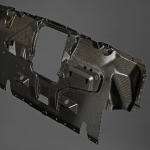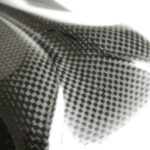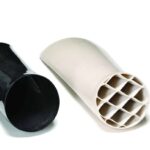Until now, CFRP materials have been used above all in premium vehicles and in small quantities on account of high material costs and time-consuming manufacturing processes that are not suitable for series production. In the context of a joint project, researchers at Daimler AG and a Canadian specialist for CFRP body structures, have successfully developed a quick CFRP manufacturing process, which is suitable for use in the automotive industry. The ultra-light rear panel of the new Mercedes-AMG S-Class produced using this process has received Composites Business Platform’s Innovation Award in Singapore.
Dr Karl-Heinz Füller, Daimler AG’s Project Manager: “In the context of our lightweight construction strategy, we have made the CFRP manufacturing process, which to date has been very expensive, once again significantly faster and therefore less expensive. The moulding and hardening process developed in cooperation with our development partner has created the requirements to now manufacture complex CFRP components in minute intervals.”
Lightweight and safe
The rear wall of the Mercedes-AMG S-Class is an element that reinforces the body shell and is of particular importance when it comes to vehicle performance. The developer’s goal was to significantly reduce the weight of the component that was previously produced using a hybrid structure of aluminium and plastic while preserving the same or even an improved functionality. This was achieved by way of double CFRP construction. Weight reduction amounts to 50 %. The innovative production process SPP – Selective PrePreg process – developed in cooperation with our project partner provides the basis for this. By means of a specifically designed epoxy resin as well as new methods of application onto the preform and new methods in the hardening process, our cooperation partner has succeeded in manufacturing complex structures in one-minute intervals. To date, the cycle times in CFRP production processes with regard to the conventional process amount to more than three minutes for a comparable geometry. SPP thus considerably increases the competitiveness of CFRP materials compared to metallic lightweight materials.
The Australian Deakin University in Melbourne (Carbon Nexus) provided Daimler AG and the Canadian partner with assistance regarding the choice of material. As part of the research campus ARENA2036, the Institute of Aircraft Design (IFB) at Stuttgart University optimised the design of the rear panel structure, which was constructed to suit the load path.
Caption nr.1
JEC Asia Award ceremony Innovation AWARD Category Automotive. From left to right: Dr. Brad Dunstan, Multimatic (CAN), Asia Pacific Engineering Director. Dr. Karl-Heinz Füller, Daimler AG (D), Manager Hybrid Materials, Concepts, AMG. Prof. Bronwyn Fox (AU), Research Director, formerly of Carbon Nexus. Prof. Peter Middendorf, IFB Stuttgart (D), Director. © Daimler AG
Caption nr.2
AMG S-Class CFRP rear panel receives Innovation Award. Innovative production process in the manufacture of carbon parts makes it possible to produce large quantities. © Daimler AG












